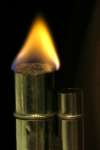 Will your old catalytic lighter still work? Will your old catalytic lighter still work?
The short answer - maybe
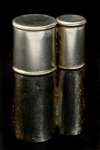 About Catalytic Lighters About Catalytic Lighters
There are many kinds of catalytic lighters. Simply put, they all use the catalytic action of platinum and alcohol (methanol) to work. They have been produced in various guises using fine platinum shavings in a steel-wool-like mesh, a small ball of platinum, platinum wires, etc. For our purposes here, Catalytic Lighters are defined to mean the tube style such as New Method and Ray-O-Lite. Catalytic lighters work just like Lektrolite lighters, but you have a better chance of actually seeing the operation with these - there is no chance to see it with a Lektrolite.
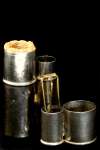 First, is it all there? First, is it all there?
There are two major pieces to these lighters. Dual tubes that come apart. Inside the larger tube is the wadding that holds the fuel. It will look somewhat like a sock turned inside out and stuffed into the tube; there will be an open area in the center to allow insertion of the catalyst section. If your lighter doesn't look somewhat like that pictured to the right... no point going further.
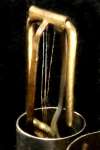 Next, do you have the catalyst element? This is the functional part of the lighter. In this Ray-O-Lite model, it is very easy to tell. Typically all of these lighters will be somewhat like this one and have thin platinum wires joining at a "ball" that acts as catalyst. Note that you can see the wires and ball in the detail photo between their surrounding framework; sometimes the wires may be arranged somewhat differently but they must be there to heat up and cause the vapor to light - the heat generated by the platinum ball. Even if they have broken, they might be wrapped around another part of this element of the lighter and may possibly work. If the catalyst ball and wires are present, the lighter has a very good chance of working. Next, do you have the catalyst element? This is the functional part of the lighter. In this Ray-O-Lite model, it is very easy to tell. Typically all of these lighters will be somewhat like this one and have thin platinum wires joining at a "ball" that acts as catalyst. Note that you can see the wires and ball in the detail photo between their surrounding framework; sometimes the wires may be arranged somewhat differently but they must be there to heat up and cause the vapor to light - the heat generated by the platinum ball. Even if they have broken, they might be wrapped around another part of this element of the lighter and may possibly work. If the catalyst ball and wires are present, the lighter has a very good chance of working.
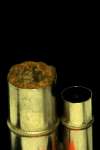 How Catalytic Lighters Work How Catalytic Lighters Work
All catalytic lighters are variations of a simple theme - the catalytic process discovered by Johann Wolfgang Döbereiner circa 1823. There is an absorbent material inside the lighter that holds the fuel - methanol (alcohol). There were different brands of this through the years; it may be substituted today using the automotive product Heet, which is primarily methanol. The lighter also uses a little platinum as the "lighter 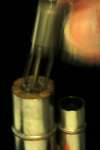 mechanism". Platinum is very resistant to corrosion,which is why many catalytic lighters may still be useable today. On contact with methyl alcohol vapor the platinum acts as a catalyst to convert the vapor into formaldehyde and, in the process, gets very hot. In turn, the heat lights the methanol vapors and starts a flame. In the picture you can see the wires glowing from the heat generated by the platinum ball - in turn starting the flame. mechanism". Platinum is very resistant to corrosion,which is why many catalytic lighters may still be useable today. On contact with methyl alcohol vapor the platinum acts as a catalyst to convert the vapor into formaldehyde and, in the process, gets very hot. In turn, the heat lights the methanol vapors and starts a flame. In the picture you can see the wires glowing from the heat generated by the platinum ball - in turn starting the flame.
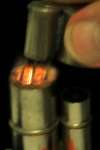 First, the lighter is filled with fuel, allowed to "soak in" briefly, the excess poured back into the fuel container (according to the more frugal directions of the day) or simply pored out. First, the lighter is filled with fuel, allowed to "soak in" briefly, the excess poured back into the fuel container (according to the more frugal directions of the day) or simply pored out.
The platinum catalytic process has been used in lighters a very long time and in many guises. Pocket hand warmers have also used this technology. Lighters such as the 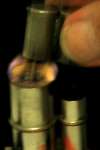 Lektrolite also used a platinum piece to work on the alcohol vapors and produce the heat reaction. Other, far older, lighters used a "platinum sponge" - a small ball of fine platinum wires (on the order of steel wool), to the same end. Lektrolite also used a platinum piece to work on the alcohol vapors and produce the heat reaction. Other, far older, lighters used a "platinum sponge" - a small ball of fine platinum wires (on the order of steel wool), to the same end.
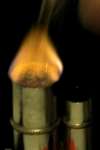 Why It Won't Light Why It Won't Light
If everything seems as though it should work and it still doesn't, there may be a problem with the platinum wires and ball; they may have a 'coating' on them. To 'clean' them up, you can light the fuel area with a match and use the flame to heat/clean the wires; or you can more easily just use a butane lighter to do the same. Do this BRIEFLY. You may need to repeat the process, but don't keep the wires in the flame a long time.
|

